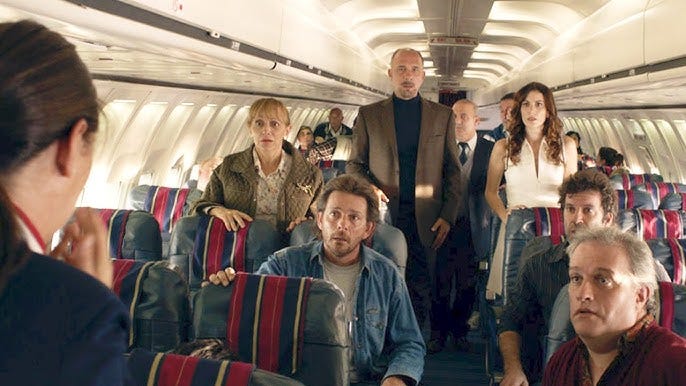Pasternak
The first short film from Wild Tales (Damián Szifron, 2014)
The first of six shorts films depicts two characters speaking on a plane, who soon discover they both know a man called Gabriel Pasternak. The woman (María Marull) is Pasternak’s cheating ex-girlfriend and the man (Darío Grandinetti) brutally reviewed Pasternak’s music. Quickly, the other passengers come to realise that they are all connected to Pasternak and have all wronged him at some point in his life, and are warned by a flight attendant that Pasternak has locked himself in the cockpit of the plane. In an act of revenge, Pasternak (who always remains a mystery to the audience) crashes the plane directly into his parents’ house, killing all those who ever wronged him.
The Narrative:
The film opens with a close-up shot of the woman’s legs walking through the airport, which immediately creates questions for the audience, such as who this might be and where she is going. The first few minutes of the film simply show a woman catching a flight and everything seems fairly normal, which keeps viewers engaged and intrigued to see what will happen. A few jump cuts later, and the woman is on the plane and a man beside her begins a conversation. With very natural and realistic dialogue, they soon understand that they both know Gabriel Pasternak. Soon, other passengers begin interrupting to say that they have also wronged Pasternak, until they all come to the conclusion that they are on this plane to be a victim of Pasternak’s revenge. The drama and tension quickly spikes within just minutes, as everyone is informed that Pasternak is about to crash the plane. This is achieved through the plane shaking, rapid camera movements, a twist in the narrative and terrified performances from the actors. One of my favourite shots from this film is at the end in the sudden jump shot from the plane to the garden of an old couple, where the plane slowly falls into Pasternak’s parents’ house and you can see their panic as they realise the plane is heading directly for them. The film ends with a still shot of the plane just less than a second before it crashes into the couple, which was nerve-racking to watch.
Cinematic Influences:
Wild Tales was filmed and based in Argentina, which was very corrupt at the time of the film’s creation, which is subtly explored throughout the short stories, through tales of revenge and social corruption, which reflect the state of Argentina at that time. The director stated that the events in Wild Tales could be set “in any country and at any other period of time,” which suggests that the political and social contexts portrayed in the film are much broader than just Argentina, and that anyone is capable of a violent outbreak of revenge due to unsettlement within society, caused by conflict. Regarding the aesthetic and cinematography of the film, Pasternak uses a minimal colour scheme to show that all of the characters are fairly normal and innocent, as their costumes have a lack of colour. The background is mostly white and blue, which colour theory suggests that it exudes feelings of calmness, which contrasts the frantic end. The sound within this film is mainly diegetic at first, which creates anticipation, and there are snippets of music, which gives viewers hope, but it builds tension because it frequently cuts in and out. The editing is quite slow at first, with shot/reverse shots during the conversation between the two main characters, but it quickly turns into more fast jump shots as the plane begins to crash to create a dramatic effect. The mise-en-scène is fairly natural and realistic, so that the ending of the story is very unpredictable and surprising. There is a subtle foreshadowing of the revenge theme within the film when the main character looks at an image of preparatory hunting their prey in her magazine, which is seen again in the opening credits. Similarly, the performances are naturalistic and only subtly hint to the plot twist when the woman tells the employee that her ticket was paid for by a company. A calm and peaceful mood is created through innocent conversations and characters smiling at each other, which contrasts and emphasises the change of atmosphere at the end. I would say that Pasternak fits into a hybrid of genres, with the plot being a drama, but the over-the-top sequence of the plane crash makes this an have an action genre. Overall, in my opinion it is a drama, however takes inspiration from action films within the cinematography and mise-en-scène during the plane crash. I think that this conforms to the traditional genre cycles of the time and place of Pasternak’s creation because this action/drama theme is seen frequently within other films from 2014.
Creating Meaning and Effect:
The main group being represented in Pasternak are innocent people who have all made mistakes within their lives, which reflects anyone watching, but I feel like the film makes them out to be the bad people, although Pasternak is the criminal because he is going to serious extremes to take revenge. The message of the film is to be careful who you wrong because you never know what else is going on in their life. This is reinforced within the performances of the film, as you can almost feel the regret that the character feels when they realise what is about to happen. The key theme is revenge, but, due to never seeing Pasternak, we feel like he is the villain because he is about to murder lots of innocent people that we feel connected to, making innocence another large theme presented in the film. The aesthetic of the film is incredibly minimalistic, which keeps the audience focused and not distracted by unnecessary bright colours or patterns. It keeps the mood calm and the pace slow through quiet editing, which emphasises the action of the plane crash at the end and makes it even more impactful and terrifying for viewers, as we feel connected to the characters after watching them share stories for a few minutes. During the sequence of the crash, the camera movements are frantic and fast-paced to create an urgent effect.
Overall, I really enjoyed this film, despite it being the shortest in length in the series. The story was quite simple, but it was very exciting and dramatic when the characters realised that they were are connected to Pasternak.
⭐️⭐️⭐️⭐️



